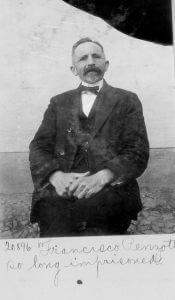Founder of Peruvian Methodism

Francisco (also known as Francis) Penzotti, an Italian immigrant to Uruguay, encountered American Methodist missionaries as they were establishing a foothold in Montevideo. His first assignment after his conversion was with the Waldensian Church in Uruguay—a Protestant denomination from Italy, closely related to Methodists in Europe. He helped to establish mission churches across Uruguay at a time when the Roman Catholic Church held a viselike grip over most of Latin America.
In 1883, the Methodist Episcopal Church sent Penzotti across the continent to Bolivia. He traveled with various colporteurs (peddlers of religious tracts and Bibles)—principally Andrew M. Milne of the American Bible Society—to establish mission posts.
In 1885, Penzotti left his wife and children in Uruguay for 14 months while he visited Venezuela, Panama, Colombia, Ecuador, Peru, and Chile. He was sent across the continent again in 1888, but a cholera outbreak kept him in quarantine in Peru for six months. During this time, he established a church in Callao, the seaport of Lima, Peru.
In July 1888, he wrote to his mission secretary, saying: “As soon as I arrived here I sought to bring the people together, and from that time I have held three meetings each week. The attendance and interest have constantly increased.”
In fact, attendance increased so much that a much larger hall had to be rented. This drew the attention of both the Catholic clergy and the Peruvian government. So, when Penzotti and a couple of colporteurs began a Bible distribution in southern Peru in 1890, they were observed by a Catholic bishop who consequently had Penzotti arrested. The case was appealed to the president of Peru, who ordered Penzotti’s release, upon which he returned to Callao.
But after the Callao Methodist Society was formally organized, persecution intensified. Notices of “Death to the Protestants” were scrawled across the door of the meeting hall. Penzotti was again arrested and thrown into jail without bail. Meanwhile, the Callao church kept growing.
Peru’s Supreme Court could not come to a decision on the case, but a couple of New York reporters published an article that garnered international interest. As a result, Penzotti was released after eight months of imprisonment. Once the ball was rolling, the U.S. Secretary of State intervened with the government of Peru, asking for assurances that the religious liberty and safety of Protestant missionaries would be guaranteed. This international attention eased the persecution suffered by the church in Peru. In 1970, the Iglesia Metodista del Perú (IMP) became autonomous. Today, it is organized in six districts under a bishop and a general assembly.
By Christie R. House, editor of New World Outlook magazine. Based on Wade Crawford Barclay, History of Methodist Mission, Volume 3, Widening Horizons, 1845-95 (The Board of Missions of The Methodist Church, New York, 1957), pp. 773-781, 784-786.




